Fort-la-Latte
Fort la Latte or Castle of the Rock Goyon is a castle in the northeast of Brittany, about 4 kilometres (2.5 mi) southeast of Cap Fréhel and about 35 kilometres (22 mi) west of Saint-Malo, in the commune of Plévenon, Côtes-d'Armor.
| Fort la Latte | |
|---|---|
Castle of the Roche Goyon | |
| Plévenon in France | |
 Castle of the Roche Goyon | |
 Fort la Latte | |
| Coordinates | 48°40′06″N 2°17′05″W |
| Site information | |
| Owner | Joüon Des Longrais |
| Site history | |
| Built | 1340 |
| Built by | Siméon Garengeau |
| Garrison information | |
| Occupants | Étienne III Goyon |
It is a famous tourist attraction of the bay of St Malo and the Emerald coast. This impressive castle was built on a small piece of land at the Bay of the Fresnay in the 13th century. Various films have been shot at this site, including The Vikings (1958) by Richard Fleischer with Kirk Douglas and Tony Curtis. It also features in the French band Manau's video for "La Tribu de Dana." A much larger, fictionalized version of the fort appears in the 2015 animated film April and the Extraordinary World.
Historical
The castle of the Roche Goyon has been classified as a monument historique by the French Ministry of Culture since 1925.[1]
The castle was built in the 14th century by the Lord of Matignon, Etienne III Gouÿon. The construction of the castle began in the 1340s, its keep dates from the years 1365-1370.
In 1379, following the return from exile of the Duke of Brittany Jean IV, the castle was besieged by Bertrand Du Guesclin. The castle was attacked and taken a second time during the Wars of Religion in the sixteenth century, this defeat marking a time of abandonment of the building. It was not until the 18th century, under Louis XIV, that the castle resumed its strategic interest and was bastioned.
It will serve until the end of the First Empire when the evolution of military techniques led to its unsuitability. From 1892, it was sold to various private owners before being bought by a passionate Frédéric Joüon Des Longrais in 1931 who undertook heavy restoration work.
Electricity only arrived at the castle in 2015.
Location
The fort is located on a rocky cap, near Cap Fréhel, in the town of Plévenon.
This site was chosen because of its favorable location, naturally not very accessible and offering a clear view of the English Channel and the Emerald Coast as well as a large part of the Bay of St-Malo. The cliffs surround the castle and its surroundings, which protects it from any invasion by the sea.
In addition, the construction materials were easily accessible: the granite came from the heart of Brittany, the sandstone could be directly recovered from the cliffs (there are moreover traces of the old quarries on the coast, revealed by toponyms such as "Port Taillé" still present on the cadastre). In addition, wood was common, with the many forests of medieval times.
The fort was an important strategic point since it was not far from the trade routes connecting Saint-Malo, Normandy and the Channel Islands.
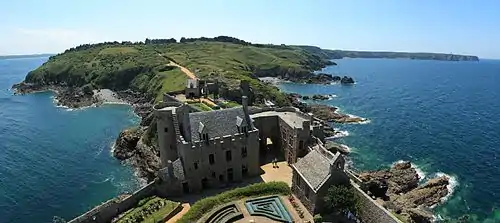
Events
Albert II, Prince of Monaco makes a private visit to the castle, July 5, 2012 in the footsteps of his ancestors the Goyon Matignon.
Festival
Since the castle opened to the public, the owners, the Joüon Des Longrais family have shared the area with visitors through various events:
- The Celtic nights of castle from 2006 to 2007 (storytelling evening with music)
- The Medieval organized in August every year since 2008, as well as the small medieval every two years.
Description

The castle is provided with two gatehouse, one opening on the barbican, the other on the courtyard of the castle; each one has its drawbridge. In the courtyard, there is a water tank, a chapel, the various defensive means (in particular the locations of the gun batteries) and of course the keep.
On the way to the castle, you can observe a small standing menhir which, according to legend, is "the tooth" or "the finger" of Gargantua.
Barbican
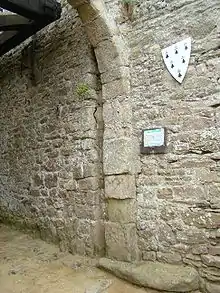
The portcullis was in the groove and the base stone supported the door. The first gatehouse of the barbican is provided with a drawbridge reconstituted in working order. At the time of its construction in the fourteenth century, it was also protected by a portcullis and a double-leaf door. Completely destroyed with a cannon shot during the second capture of the castle, it was subsequently rebuilt.
In front of this first gatehouse, there is also a battering ram and a pillory.
The barbican is decorated with a small medieval garden. A "Bricole", a kind of catapult, as well as a panorama of the bay of St Malo are also present.
The courtyard
The courtyard shelters numerous installations, such as the cistern, the chapel built under Louis XIV, the governor's house and the keep. Completely backfilled in the 17th century to use the cannons, the original medieval soil is up to eight meters deep below the current soil. Archaeological excavations have also revealed a square tower which probably served as a watchtower entirely buried underground. A second building protects the courtyard. There is in particular an dungeon. Equipped also with a drawbridge and a portcullis, only the two medieval towers remain, the rest (and in particular the upper floor) having been pulverized by the cannonade of the sixteenth century. The respective drawbridges of the two gatehouse are not on the same axis in order to hinder the maneuvers of the battering rams.
 the oven to blush the balls
the oven to blush the balls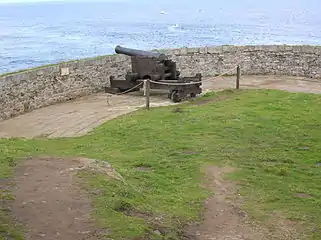 a canon.
a canon. a canon.
a canon.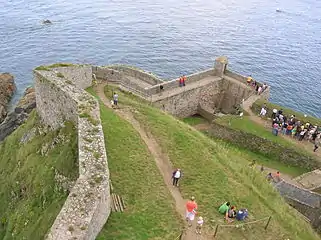 Exterior view
Exterior view Interior courtyard of Barbican
Interior courtyard of Barbican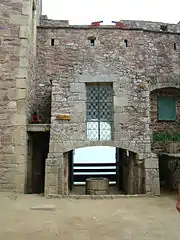 The cistern
The cistern Interior of the chapel.
Interior of the chapel.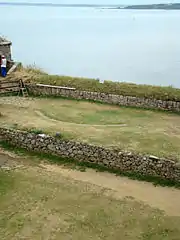 Path of the rolling.
Path of the rolling. The cistern.
The cistern.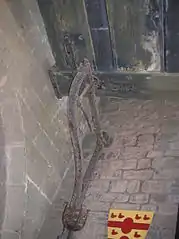 Drawbridge blocking system
Drawbridge blocking system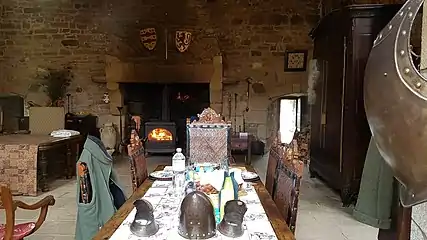
Interior of the stately home
The cistern
The water cistern, with a capacity of 20,000 L, should be able to serve the entire garrison (about forty men), which given the maximum retention volume seems little. A rainwater recovery system was put in place.
At the level of the tank, a dummy drawbridge was intended to deceive any maritime attackers who were then heading towards an area of strong currents where their ship was going to smash against the rocks. This dummy drawbridge was, however, ineffective.
The cannons
There were eight cannons under Louis XIV. The larger ones were eight meters long. Only "medium" copies are present on the site, which could send a ball up to a kilometer away. The ballistic adjustments were facilitated by the runway, that is to say an arc of granite circle which made it possible to guide the wheels of the gun.
According to military records, one shot could be fired every three minutes.
Oven to blush the balls
The Chateau of the Roche Goyon also has a ball oven for red-hot cannonballs. This installation was after all very little used for several reasons:
- the oven consumed a lot of wood ;
- for this to be effective, it had to heat for eight hours, which gave the enemies plenty of time to flee;
- loading the cannon was much more dangerous, as the hot ball could explode the black powder.
Of these ball ovens we have remained the french expression: "Shoot with red balls"
The keep
The keep is equipped with machicolations and several types of loopholes: the crossbowmen in the shape of a cross for crossbow shooting and the very long single slit archeries for archery. Holes for shooting with the arquebus (smaller holes located on each side of the loopholes) and bombard (large hole). A line of bombardment is visible at the level of these loopholes and corresponds to the capture of the castle in the sixteenth century which was accompanied by a cannonade from the keep.
Four sculptures representing the tetramorph according to Ezekiel are found at the level of the yellow granite circle which surrounds the keep. We thus find, facing the castle, the angel of Saint Matthew, then the lion of Saint Mark, the eagle of Saint John (very damaged by time) and finally the bull of Saint Luke to the right of the entrance to the keep .
The entrance to the keep reveals the presence of a third drawbridge, now replaced by a staircase. The emblem of the Goyon-Matignon, a siren, crowns the passage. The entrance to the keep was protected by a portcullis and a stunner in the mousetrap. In the keep, there is an exhibition on the restoration works of the castle. The last part supports the roof by a cross vault of warhead dating from 1340.
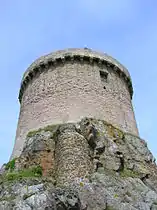 The keep.
The keep.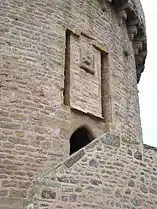 Enter of the keep.
Enter of the keep.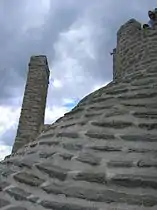 The roof of the keep.
The roof of the keep.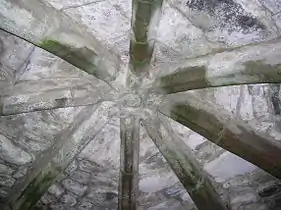 interior arched warhead
interior arched warhead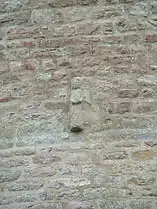 The angel of st Mathieu
The angel of st Mathieu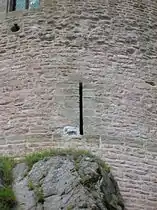 The lion of st Marc.
The lion of st Marc.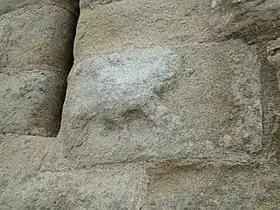 The eagle of st Jean.
The eagle of st Jean.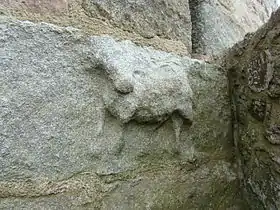 the beef of st Luc.
the beef of st Luc.
the first floor 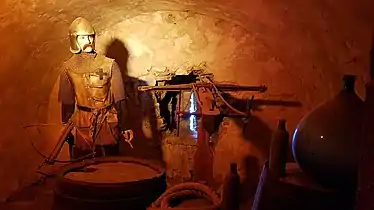
reconstituted powder scene
The menhir of La Latte
On the path leading to the castle stands the menhir of La Latte which would represent the tooth or the finger of Gargantua.
The legend says that this one would have lost it while it spanned the English Channel in order to join the coasts of England. There are also traces of his hooves and cane.
Another legend says that Gargantua died at Cap Fréhel after a hard fight with korrigans. They say that all the islands that we can see in the sea around the cape would be pieces of the giant and that this standing menhir would represent his finger which would have fallen here and got stuck in the ground.
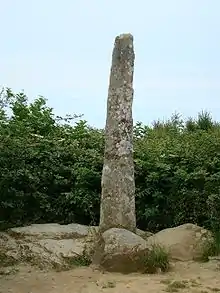
bibliography
- La Châtelaine aux deux visages, by Simone Roger-Vercel, 1957
- Le Jeu du Roi, by Jean Raspail, 1976
- Le Fantôme de Fort La Latte, comics strip from "Aventures de Vick et Vicky" by Bruno Bertin by Éditions P'tit Louis, 2007
- Le Fort La Latte, by Isabelle Joüon Des Longrais by éditions Ouest-France, juin 2009
- Le Chemin de Malefosse, comics strip by Daniel Bardet and Brice Goepfert, by éditions Glénat, 2015
- Christophe Amiot, Le fort La Latte, anciennement Roche Goyon, in french Archaeological congress. 173rd session. Monuments of Côtes-d'Armor. « Le Beau Moyen Âge ». 2015, Franch Archaeological Society, 2017, p. 97-110, (ISBN 978-2-901837-70-1)
- Sekijô No Shi, Le Château de la Roche Goyon dit Fort la Latte, imprimerie de la Manutention, 1973, (ISBN 2-9501512-0-5)
- Le secret de Fort La Latte, by Valérie Thiébaut published by Héros d'Armor, 1er décembre 2017.
Filmography
This castle served as a setting for several scenes from the following films, television films, television series and clips :
- The perfume of the lady in black, 1931
- The Three Musketeers, 1948
- The Vikings (Vikings) 1958, with Kirk Douglas, whose final fight took place on the keep.
- Metzengerstein one of the sketches from the film Extraordinary Stories, 1967.
- Lancelot du Lac, 1970.
- The Dance of Death, 1983.
- Chouans!, french film 1987.
- The King's Game, 1988.
- Ridiculous, 1996.
- The heart and the Sword (Il cuore e la spada, Heart and Sword) 1998.
- La Tribu de Dana, clip from the French band Manau, 1998.
- Tv advertising for the search engine "Lycos" 2000
- Une vieille maîtresse, french film 2007.
- L'Épervier, the series for France Télévision with Aurélien Wiik, Martin Lamotte 2011.
- Avril and the extraordinary world, animated film, 2015.
- Ma Reine, clip from the French band Manau, 2018.
- Tasnif-e magali Kurdi, clip from the French medieval band Soñj, 2018.
See also
References
- Base Mérimée: Fort de la Latte, Ministère français de la Culture. (in French)
External links
| Wikimedia Commons has media related to Fort-la-Latte. |
- Fort la Latte and Fréhal
- Base Mérimée: Fort de la Latte, Ministère français de la Culture. (in French)